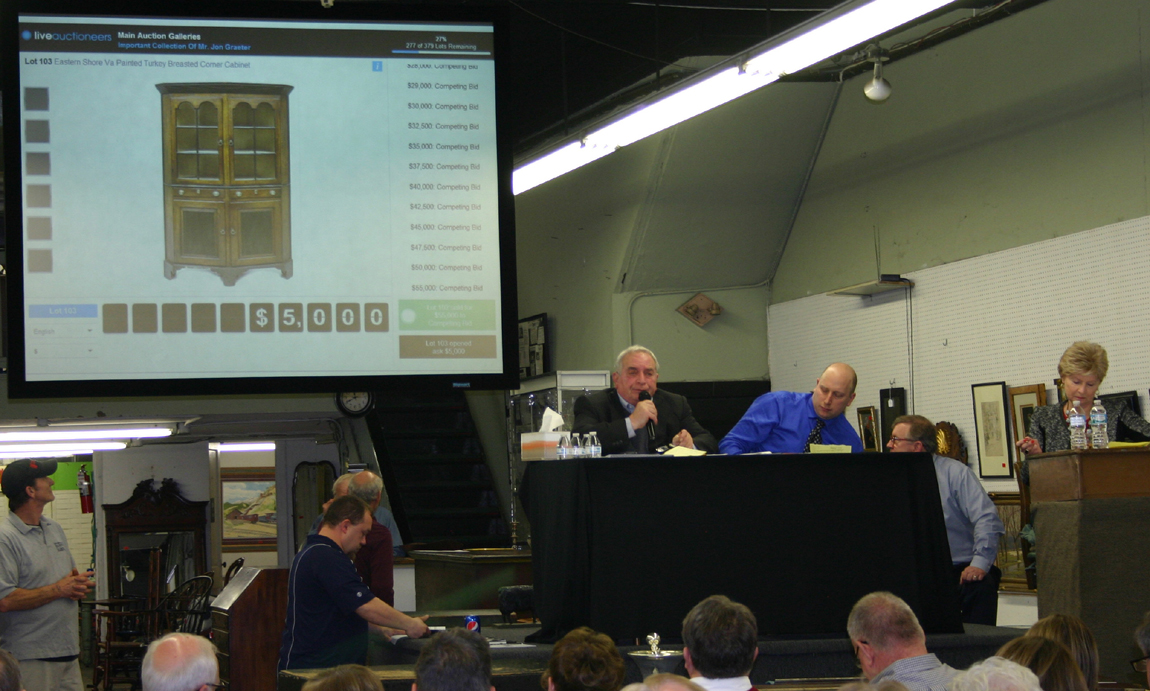Review By Hollie Davis, Photos Courtesy Main Auction Galleries
CINCINNATI, OHIO — The early bird catches the worm but at Main Auction Galleries’ February 28 sale of items from the Americana collection of Jon Graeter, the early birds in the crowd got seats.
Even with 180 chairs shoehorned into the storefront space in downtown Cincinnati and all the furniture offered pushed back to the walls, at least a third of the crowd was spilling out onto the sidewalk, craning their necks to get a glimpse as some truly exceptional works crossed the block.
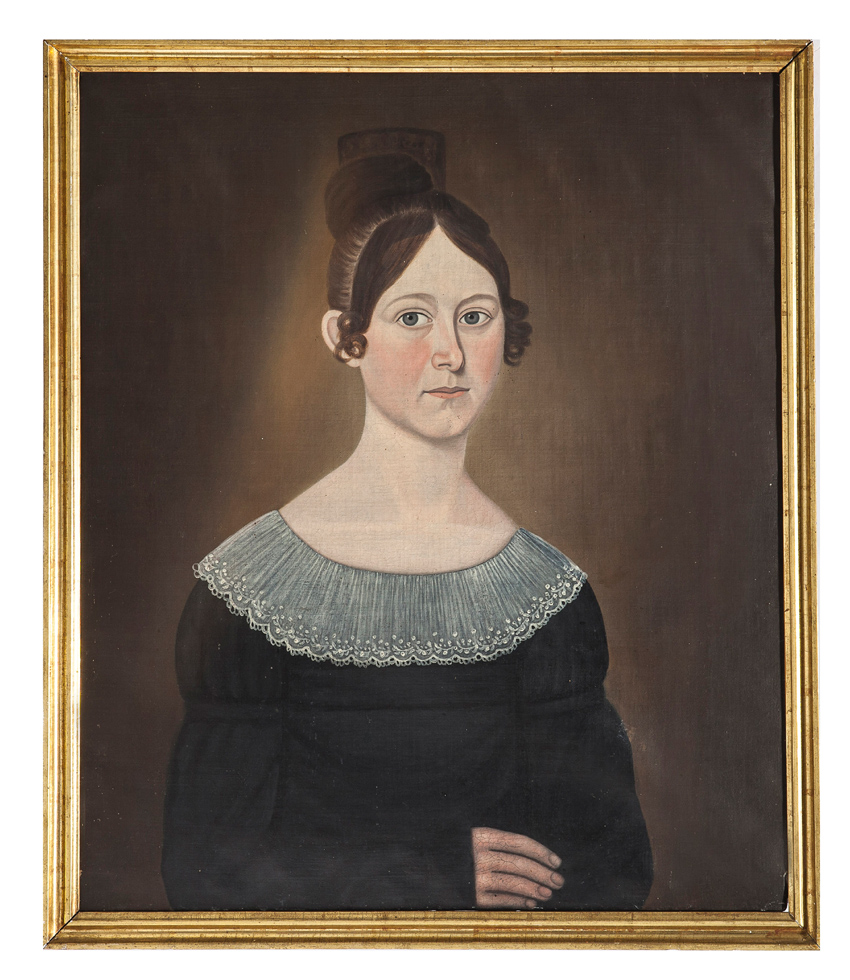
The top lot of the day was this charming portrait of a young lady by John Brewster. Aside from a very small hole in the canvas, the painting was in exceptional condition, and brought the exceptional price of $77,500.
One can only estimate how many bidders were in attendance, because part of Main Auction’s appeal is its old school methods. In-house bidders don’t register — you get something, stick your hand up and give your initials. J. Louis Karp, or Jay as he’s known, and Main Auction Galleries are a Cincinnati institution, right up there with the Cincinnati Reds and Cincinnati chili, neither of which predates the business, which was purchased by the Karp family in 1870.
Graeter’s ice cream is another Queen City institution, founded by Louis Graeter the same year the Karps got into the auction business. Graeter’s French pot process, which makes ice cream in 2-gallon batches at a time, built a family empire, and his grandsons, Jon, Dick and Lou, ran the company for the last half of the Twentieth Century. Graeter’s ice cream may not be well known outside of the Queen City, although that’s changing with national retail distribution, but there, it is a local treasure.
Jon and his long-time partner George Hammon developed a passion for Americana and spent decades seeking out top-shelf examples, buying both at auction and from the finest Americana dealers, such as Bill Samaha. Graeter, who died in 2013, did much of his buying in the 1970s through the 1990s, so this offering included objects that have been off the market for a number of years.
With the formalities required by absentee, phone and Internet bidding, however, it is a little easier to gauge the number of interested bidders. Jay reports there were more than 2,200 bidders registered for the auction, but it was easy to believe they were all in attendance, however, as the crowd looked like a lineup from an impressive antique show, with well-known dealers and collectors from much of the country in attendance. In addition to those from Midwestern states and neighboring Pennsylvania and Kentucky, there were plenty of familiar faces who had made the trip from as far away as New England and Florida as well.
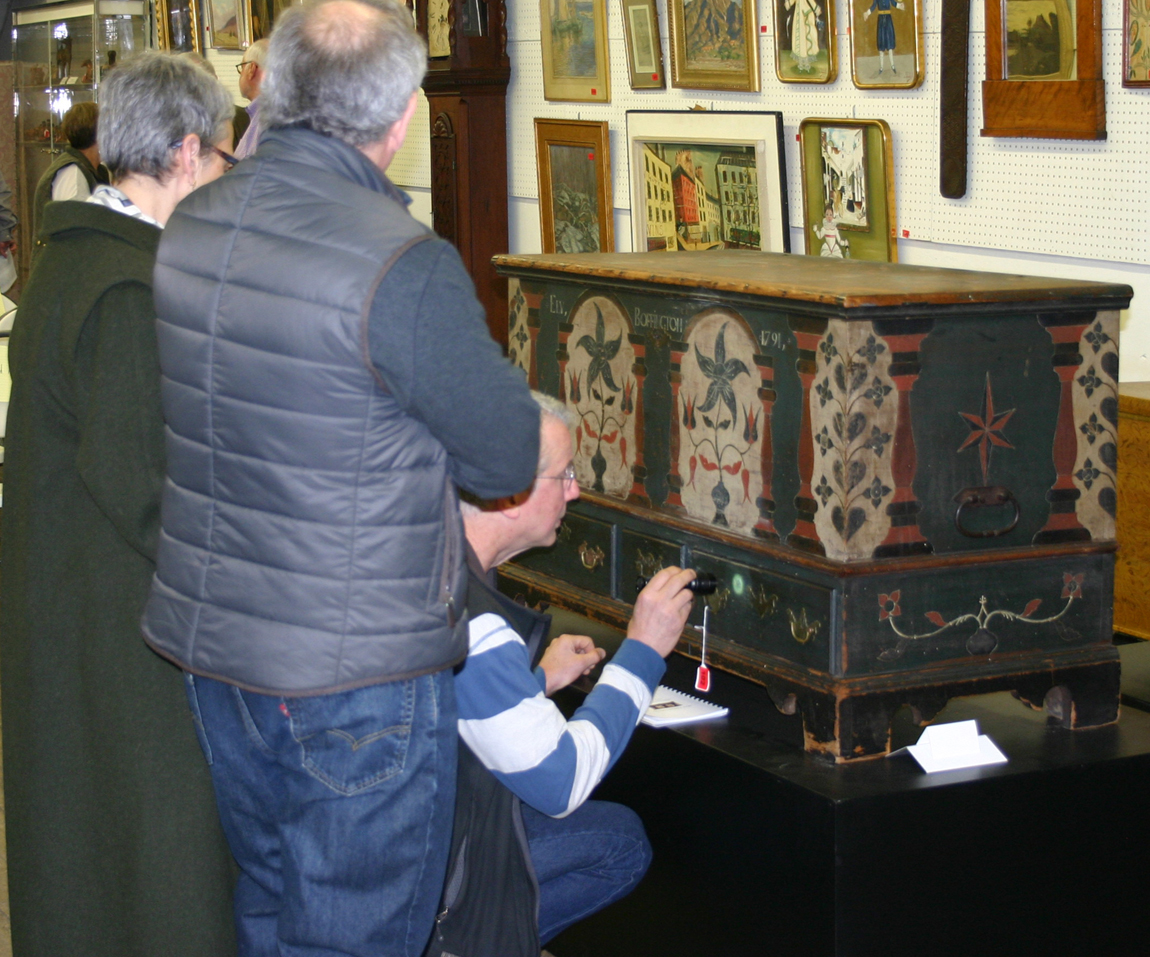
One of the stars of the sale, this 1791 Berks County, Penn., decorated blanket chest received much attention during preview. It opened at $5,000 and quickly escalated, finally stopping at $55,000 to a dealer in the room.
Karp reported that presale interest was normal, but then again, his modesty makes it all but impossible to get an opinion beyond, “What can I say? It was an awesome sale! You can say I said anything you want!” His generosity is not limited to reporters, which is part of what makes him so beloved. Show up for one of his weekly Tuesday sales and you will be forced to eat at least three donuts. The preview party, for which the saleroom was beautifully arranged, was lavishly catered, and leftovers were brought in for the crowd to polish off. As the sale wound on into the afternoon, about a dozen pizzas were delivered. And Jay keeps a bag of quarters on him, so no one with a spot on the street has to pay for parking.
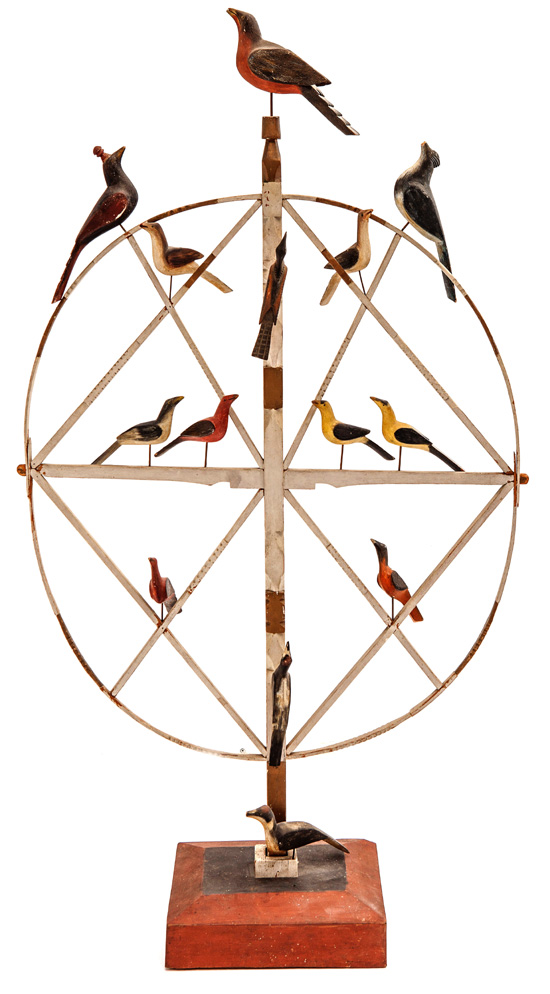
At just over 4 feet high, this carved and painted bird tree had a commanding presence. It also commanded a great price at $26,000.
The sale was comprised of 369 lots, 250 of which were from Graeter’s collection. It opened with 50 lots of art, heavily weighted toward Twentieth Century and European and none of it from Graeter’s collection, then shifted gears at lot 51 with a string of Lehnware. (Some of the Lehnware and other pieces of Americana were not from the Graeter collection either.) A cup and saucer with a vibrant yellow ground set the high water mark for the Lehnware when it brought $10,000.
A Richmond, Va., leather key basket, one of a number of well-documented baskets, sold to local collectors for $3,700, while the plentiful Pennsylvania buyers battled it out over several good fraktur pieces. A fraktur birth record from 1830 for David Herschey with bird decoration, flew past the $200/400 estimate to land at $3,500.
The finest pieces of the sale were among the furniture lots; the first of which were ushered in with a bang when a 1791 Berks County, Penn., blanket chest came up for bid. The sale offered only a selection of Graeter’s collection, and Karp lamented that he did not have access to all records or provenance documents for the pieces consigned. The Berks County chest, for instance, had a Sotheby’s label, so certainly some of the interested bidders had tracked it down. Competing dealers sped right by the $10/15,000 estimate, with the victor taking it home for $55,000.
Another dealer got a deal with the next lot, a Virginia “turkey breast” corner cupboard, which sold for $20,000. According to the catalog, when it sold at Christie’s in 1983, it set a world record price for painted furniture at $90,000. Jim and Susan Widder, Ohio collectors and long-time friends with Jon, remembered being with him when he bought it. “Jon was sitting with us,” Susan recalled, “and suddenly got up and moved to the rear. The next item up was the turkey-breasted cupboard and it went for, at that time, a huge amount. Then Jon came back, sat down, and said with a grin, ‘Well, I got it.’ Not a word beforehand!”
Estimates were, to put it mildly, conservative and widely ignored. With low estimates across the board, enthusiastic bidders were jumping bids to keep things moving. Jay’s son, Jonas, the fifth-generation Karp to work the auction block at Main Auction, shares the auctioneering duties with his dad, and when not selling, Jay executes absentee bids, often revealing the amount left after an item sells, just to reinforce their honesty and transparency in handling bids. Bids were jumping high enough and fast enough that Jay, ever the entertainer, was clutching his chest and feigning collapse. (A video made the rounds via Facebook after the sale showing some of his most entertaining PG-13 moments.)
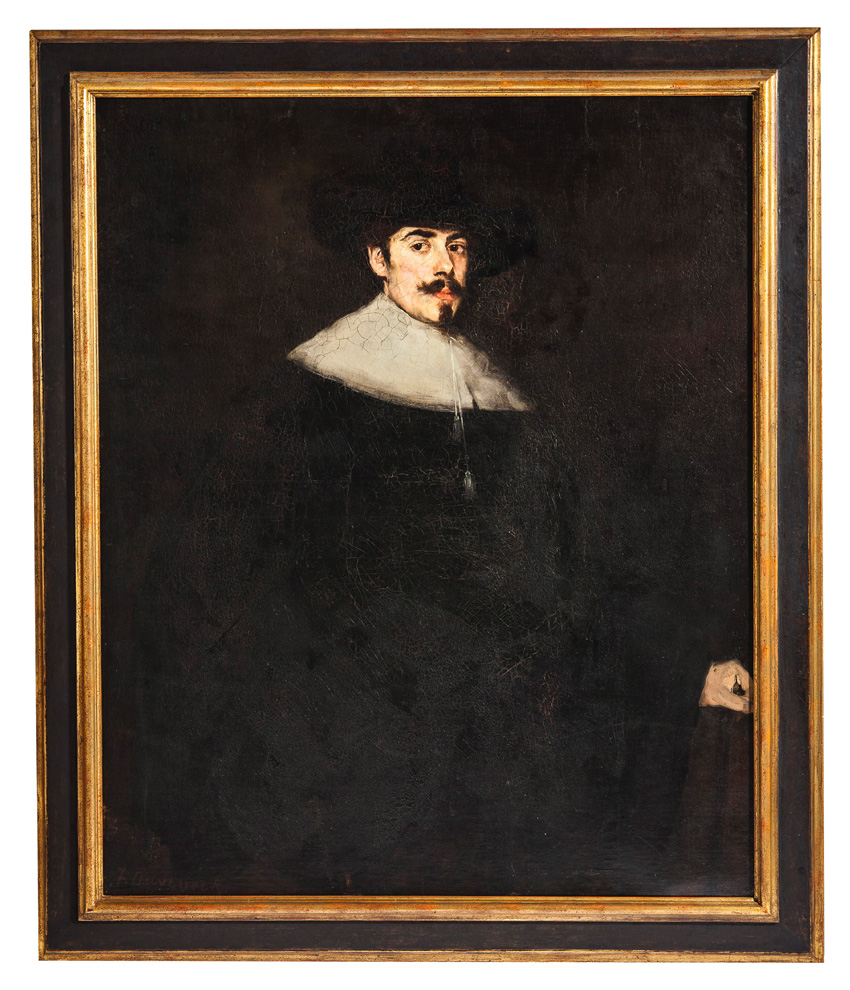
As a lifelong Cincinnatian, it’s no surprise that Jon Graeter also had an interest in iconic Cincinnati artists. This large portrait by Frank Duveneck sold for $22,000.
A hanging corner cupboard, sold by Sotheby’s in 1986 as part of the Don and Faye Walter sale, was cataloged then as Mahantango Valley. Pennsylvania decorative arts have been much better researched in the intervening decades and just this past November, Garth’s Auctions sold a similarly decorated box in its annual Thanksgiving sale. Both are likely from Somerset County, Penn., and despite some significant losses to the cornice, the hanging cupboard still brought $19,500.
It was also a good day for “brown wood,” with the traditional pieces of furniture from Graeter’s collection performing well. An inlaid Pennsylvania Chippendale chest, bearing a vintage Bill Samaha New York Antiques Fair label, was snatched up for $8,000, while a Queen Anne mahogany “handkerchief” table, brought $4,100, which was roughly ten times the opening bid, and a New England Queen Anne tavern table in an appealing diminutive size having an equally diminutive estimate of $100/200 fetched $6,750.
Perhaps the most chatter was about a curly maple pie safe, which was an unusual form, having three drawers below the tin-panel doors. A Pennsylvania dealer helped it quadruple its estimate, taking it home for $20,000. But some people were also surprised by the inclusion of more than 50 lots of Steuben glass. While it is admittedly not typical of an Americana collection, Graeter discovered Steuben later in life and bought up great examples, including the top Steuben lot, a sculpture titled “Howl at the Moon” and designed by James Houston, which brought $3,600.
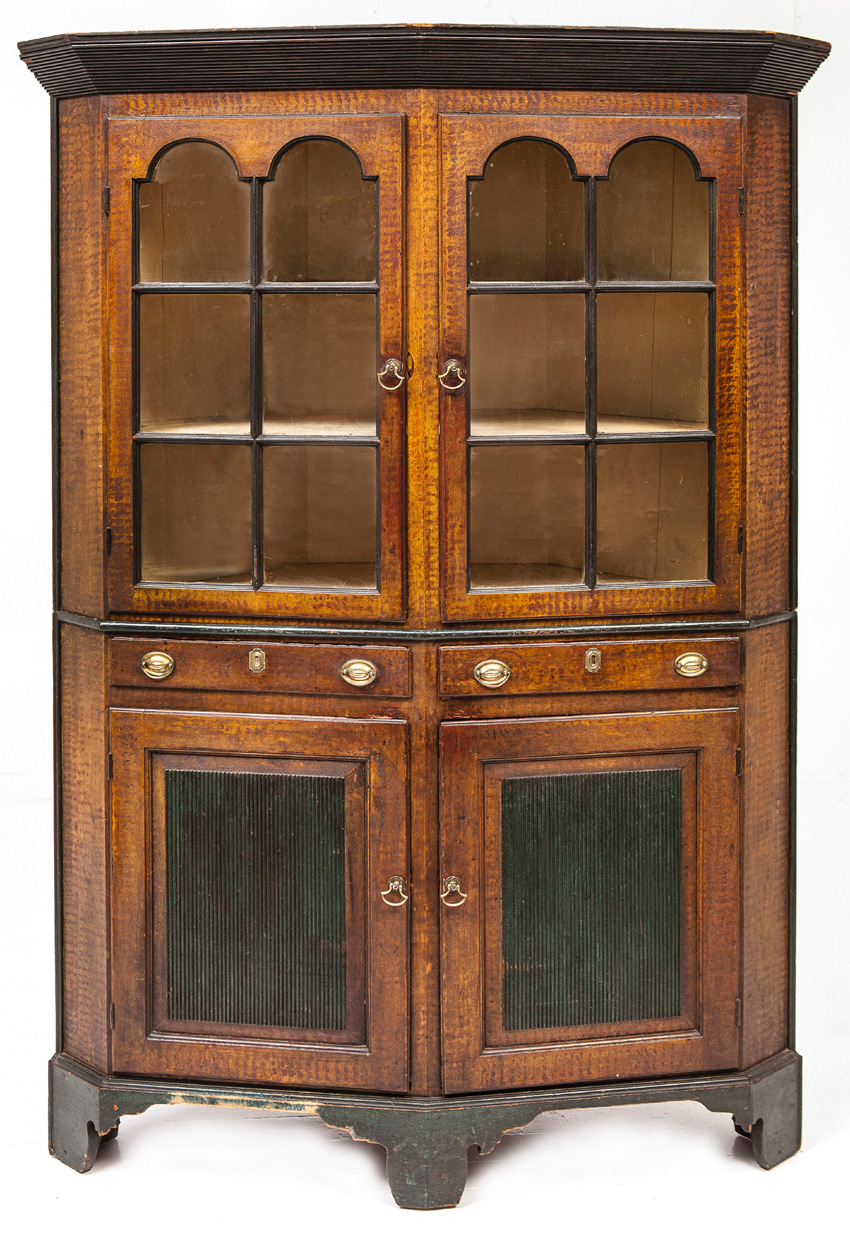
The so-called “turkey breast” corner cupboard is a rare form, and the Virginia attribution to this one surely added to the interest. It sold in the room for $20,000.
Graeter had a fine eye for art as well, with a John Brewster portrait of a young lady selling after a lengthy battle to a phone bidder for $77,500; a still life, streaking past the $1,5/2,000 estimate to sell for $19,000, and a Noah North portrait of a woman identified as Mrs Sally Garge reaching $6,000. As a collector, Graeter also sought out prime examples from Cincinnati’s rich artistic history and the work of several well-known Cincinnati artists was also up for sale, including a selection of works by Frank Duveneck (1848–1919), one of which was the top lot of Cincinnati art at $22,000.
Jay Karp is known as a straight shooter, the kind of guy who will point out condition issues from the block if the bidding gets more aggressive than he anticipated. (“You know it’s got a big patch, right?”) He is a man who has opinions and will happily share them. By the end of the day, the sale total approached $750,000, dozens of people had come together and reminisced and bought great art, and Main Auction Galleries has another one for the books. Maybe Jay’s brevity when asked to comment on the sale was exactly right — it was an awesome sale.

